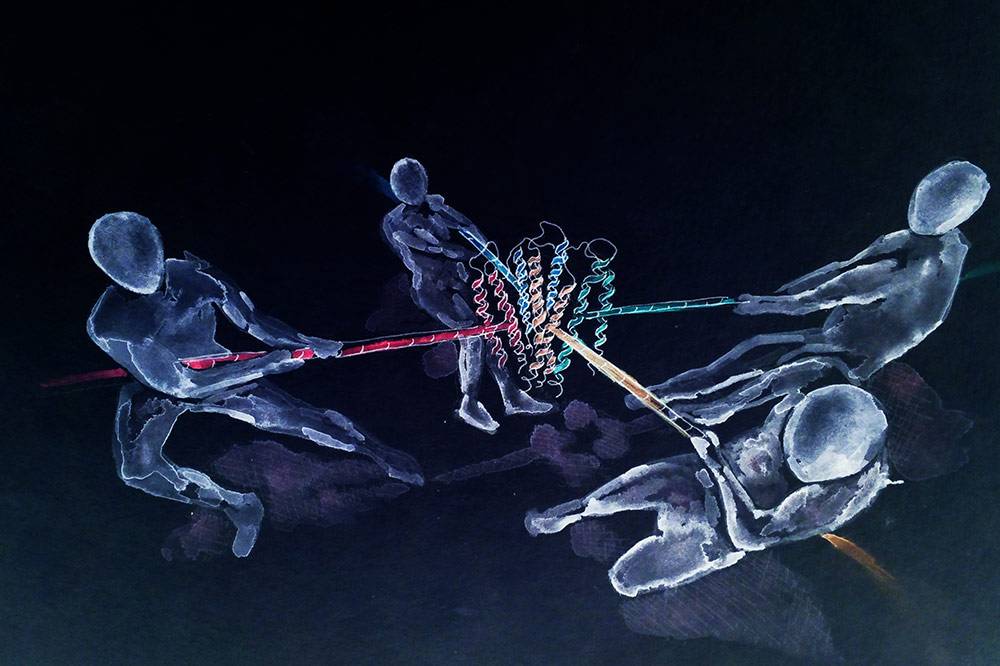A Tour de (Tiny) Force
Researchers Apply Inconceivably Small Force To Mysterious Receptor

From the blood coursing through our veins to the fly landing on our arm, we sense forces both inside and outside of our bodies through certain receptors on our cells. A new Duke University study takes researchers a step further to understanding a crucial receptor whose dysfunction has been linked to rare blood disorders.
Described Oct. 3 in the journal Nature Communications, the technology generated for this new finding -- manipulating a single protein using magnetic fields and simultaneously measuring effects on a cell -- represents a new tool for researchers who want to apply the tiniest touches to receptors in living cells.
“This study was a heroic effort,” said the study’s senior investigator Jörg Grandl, an assistant professor of neurobiology in the Duke School of Medicine and member of the Duke Institute for Brain Sciences. “Here, we’re able to draw inferences about the purpose of different parts of a receptor by mechanically manipulating it in very specific locations.”
Discovered in 2010, Piezo1 is a gargantuan protein. It sits on the membranes of cells, where, as one of the largest ion channels, its opening and closing translates into information about the forces surrounding the cell.
Piezo1 is found in red blood cells and is mutated in hereditary stomatocytosis, a rare disorder in in which red blood cells burst from lack of balance in water and salt. The channel is also found in many other areas of the body, such as the lungs, bladder and skin. Its mechanisms are still unclear.
Four years ago, graduate student Jason Wu in Grandl’s lab began developing a method to apply force to a specific part of Piezo1 to figure out how it works.
The traditional way that scientists prod cells is by using a method called atomic force microscopy. However, previous research showed that even this tool was too brawny for Piezo1, ripping it out of the membrane.
“From these studies, we knew what kinds of forces were destructive for the protein,” Grandl said. “A very small force range was important for the study. We didn’t want to destroy the protein.”
In the new study, Wu attached tiny (nanometer-sized) magnetic beads to different regions of the receptor. Wu navigated by trial-and-error at nearly every step, including choosing the right magnetic beads and figuring out the strength of magnetic field to apply. Also, because Piezo1 is large, it has many sites on which to attach beads, and Wu had to figure out exactly where to put them.
Ultimately, the force that Wu applied to the protein is just barely above the energy level that the protein experiences sitting in a cell, in a dish, at room temperature.
In the end, to the group’s surprise, the forces that wound up affecting the channel did so not by activating (opening) it, but by changing its behavior while it was already activated. Although they had hoped to activate the channel, Wu was not discouraged.
“In a way it was more exciting than getting it to activate,” Wu said. In particular, “we were pleased to see that our manipulation affected one specific property of how the channel worked.” Activating the channel is next on the group’s list.
They also hope to be able to remotely manipulate cells with magnetic fields, which would allow them to control the brain activity in animal models of disease. In neuroscientists’ ever-expanding toolbox, there are other strategies, using light or specific chemicals, to be able to drive circuits of neurons for a better understanding of brain function. But if they can get it to work, the use of magnetic fields could offer important advantages over these methods, Grandl said.
“This would be a very exciting tool, and we’re working very intensely toward this goal,” Grandl added.
The study was funded by the Klingenstein Fund, Duke University, and the National Institutes of Health (1F31NS093777-01).
CITATION: " Localized force application reveals mechanically sensitive domains of Piezo1," Jason Wu, Raman Goyal, and Jörg Grandl. Nature Communications, Oct. 3, 2016.
DOI: 10.1038/ncomms12939